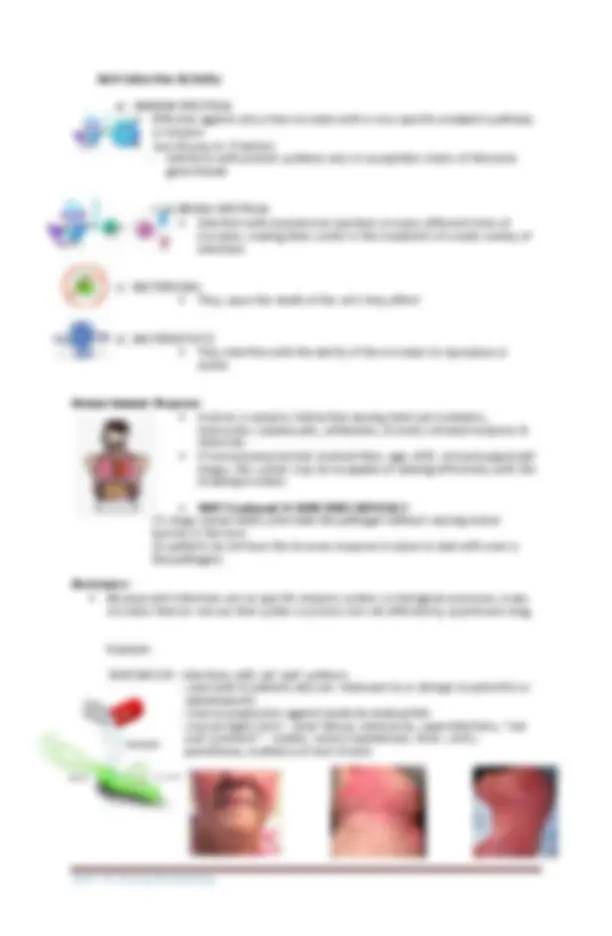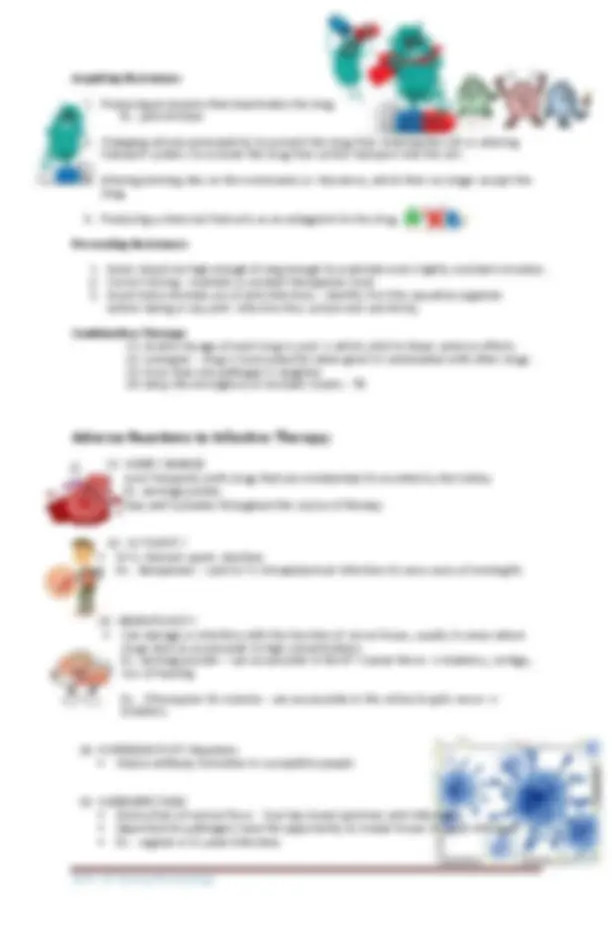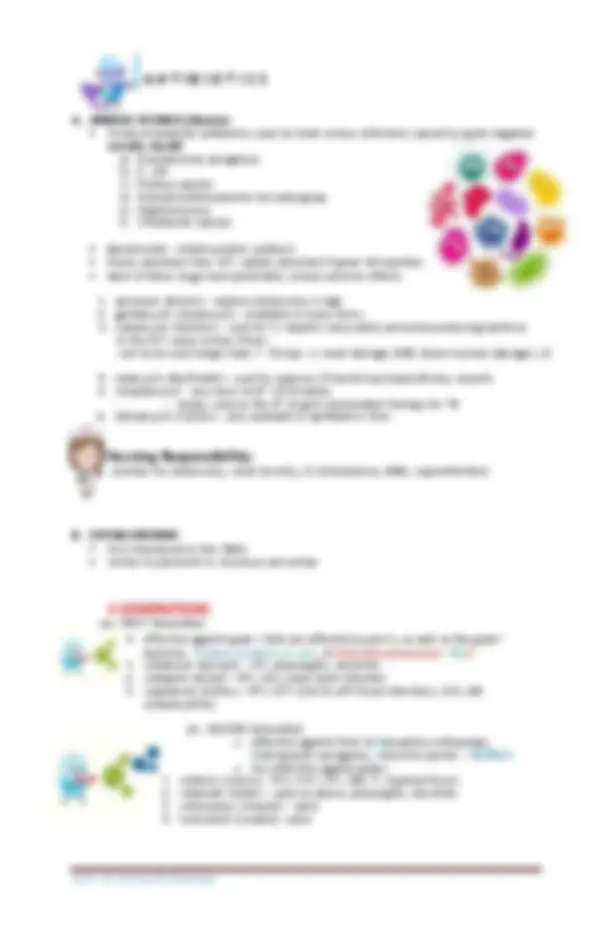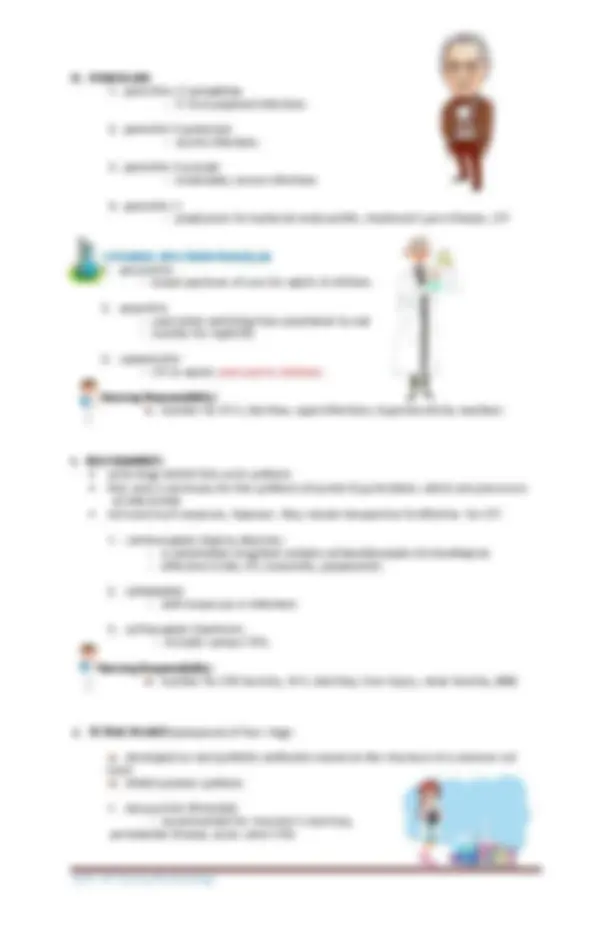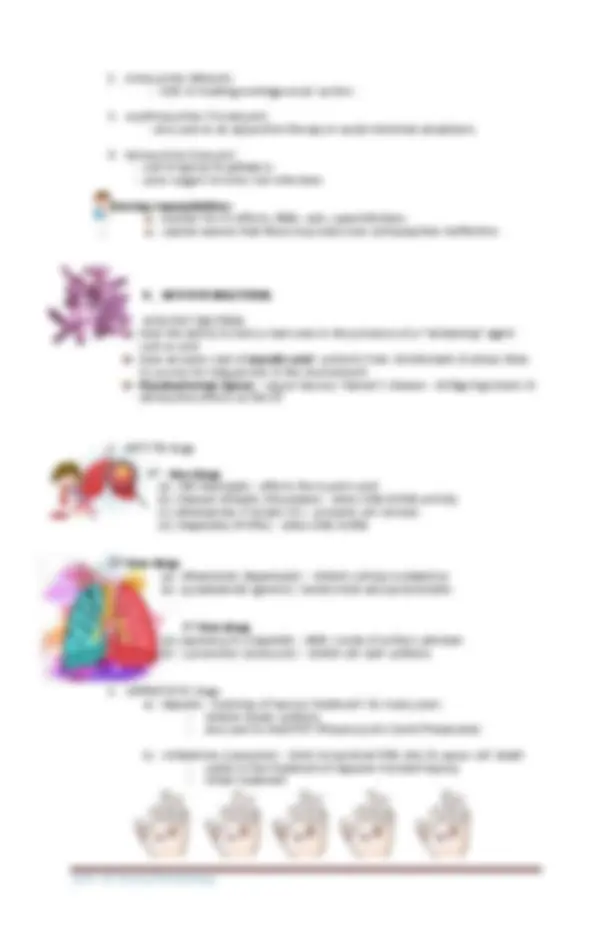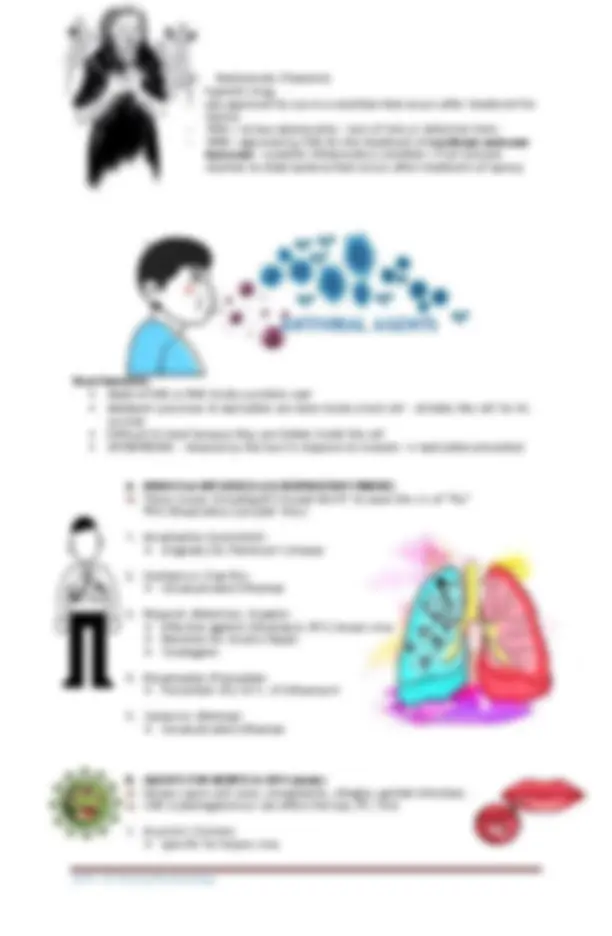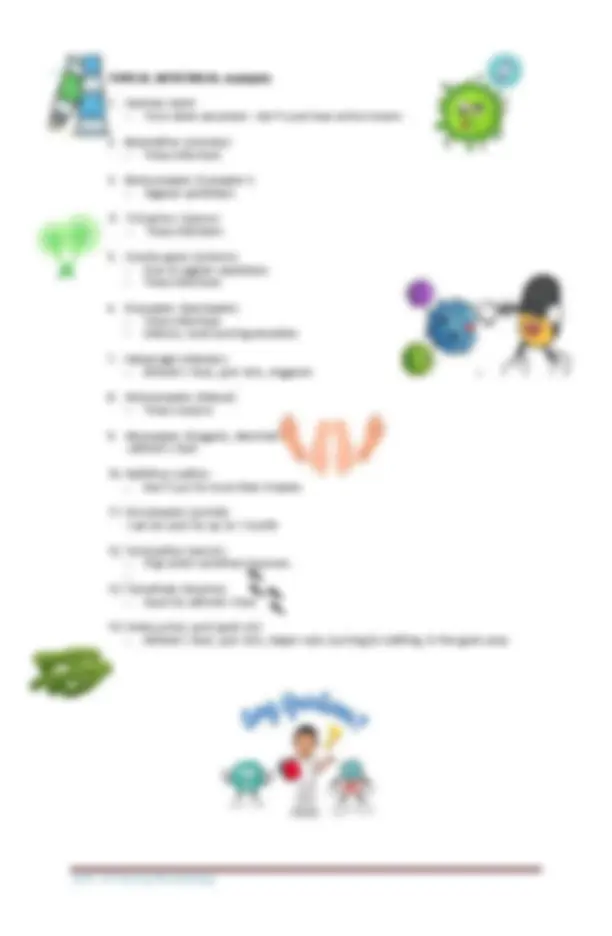Download Anti-Infective Drugs: Mechanisms, Types, and Nursing Considerations and more Lecture notes Pharmacology in PDF only on Docsity!
NUPC 107
NURSING
PHARMACOLOGY
MODULE 3
DRUGS AFFECTING THE DIFFERENT SYSTEMS
COURSE CONTENT
LESSON 1 ANTI-INFECTIVE AGENTS
LESSON 2 RESPIRATORY DRUGS
LESSON 3 CARDIOVASCULAR DRUGS (INCLUDING DIURETICS)
LESSON 4 GASTROINTESTINAL DRUGS
LESSON 5 ENDOCRINE DRUGS
REFERENCES
Books: Blaine Templar Smith & Diane F. Pacitti; Second Edition 2020. Pharmacology for Nurses Cate Whittlesea & Karen Hodson; Sixth Edition 2020. Clinical Pharmacy and Therapeutics Bertram G. Katzung; 14th Edition 2018. Basic & Clinical Pharmacology Amy M. Karch; Seventh Edition 2017. Focus on Nursing Pharmacology Jacqueline Rosenjack Burchum & Laura D. Rosenthal; Tenth Edition 2019. Pharmacology for Nursing Care Wolters Kluwer; 41st Edition 2021. Nursing 2021 Drug Handbook Heimgartner, N.M. et al; Fourth Edition (2017). Pharmacology made Incredibly Easy Websites: http://nursingcrib.com/practice-tests/ http://nursingcrib.com/category/nursing-notes-reviewer http://nursing crib.com/category/nclex-cgfns/http://nurseslabs.com http://www.nursingschoolhub.com/top- 10 - blogs-nursing-students/
Ariel D. Abenoja, RN,SCFHS-RN, MANc
Jerome Molina, RN, MANc
CCHAMS Faculty 2022
DRUGS AFFECTING THE DIFFERENT SYSTEMS ANTI-INFECTIVE AGENTS Definition: Drugs that are designed to act selectively on foreign organisms that have invaded & infected the body of a human host Goal: To reduce microbes to a point at which the human immune response can take care of the infection. When infection attacks the body, anti-infective drugs can help turn the tide of battle. Four types of anti-infective drugs exist: antibacterial, antiviral, antitubercular, and antifungal
Drug Therapy Across the Lifespan:
CHILDREN
Use with medications caution because early exposure can lead to early sensitivity Monitor nutritional status & hydration status ADULTS Drug allergies & emergence of resistant strains can be a big problem Pregnant & nursing women – use cautiously OLDER ADULTS C&S tests are important to determine the type & extent of many infections – often do not present s/s seen in younger people Monitor nutritional & hydration status Hepatotoxic & nephrotoxic drugs be used with caution – decreased organ function
Mechanisms of Action:
- Interfere with biosynthesis of the bacterial cell wall Ex. Penicillins
- Prevent the cells of the invading microbes from using substances essential to their growth & development, leading to an inability to divide & eventually cell death Ex. Sulfonamides, anti-TB drugs, Trimethoprim
- Interfere with the steps involved in protein synthesis Ex. Aminoglycosides, Macrolides, Chloramphenicol
- Interfere with. DNA synthesis in the cell, leading to inability to divide & cell death Ex. Fluoroquinolones
- Alter the permeability of the cell membrane to allow essential cellular components to leak out, causing cell death
Acquiring Resistance:
- Producing an enzyme that deactivates the drug Ex. penicillinase
- Changing cellular permeability to prevent the drug from entering the cell or altering transport systems to exclude the drug from active transport into the cell.
- Altering binding sites on the membranes or ribosomes, which then no longer accept the drug.
- Producing a chemical that acts as an antagonist to the drug Preventing Resistance:
- Doses should be high enough & long enough to eradicate even slightly resistant microbes.
- Correct timing – maintain a constant therapeutic level
- Avoid indiscriminate use of anti-infectives – identify first the causative organism before taking in any anti- infective thru culture and sensitivity. Combination Therapy: (1) smaller dosage of each drug is used which yield to fewer adverse effects (2) synergism – drug is more powerful when given in combination with other drugs (3) more than one pathogen is targeted (4) delay the emergence of resistant strains – TB Adverse Reactions to Infective Therapy: (1) KIDNEY DAMAGE most frequently with drugs that are metabolized & excreted by the kidney Ex. aminoglycosides Stay well hydrated throughout the course of therapy (2) GI TOXICITY N/V, stomach upset, diarrhea Ex. Meropenem – used to Tx intraabdominal infections & some cases of meningitis (3) NEUROTOXICITY Can damage or interfere with the function of nerve tissue, usually in areas where drugs tend to accumulate in high concentrations Ex. aminoglycosides – can accumulate in the 8 th^ Cranial Nerve dizziness, vertigo, loss of hearing Ex. Chloroquine for malaria – can accumulate in the retina & optic nerve blindness (4) HYPERSENSITIVITY Reactions Induce antibody formation in susceptible people (5) SUPERINFECTIONS Destruction of normal flora – true top broad spectrum anti-infectives Opportunistic pathogens have the opportunity to invade tissues & cause infections Ex. vaginal or GI yeast infections
A N T I B I O T I C S A. AMINOGLYCOSIDES (Mycins) Group of powerful antibiotics used to treat serious infections caused by gram-negative aerobic bacilli a) Pseudomonas aeruginosa b) E. coli c) Proteus species d) Klebsiella-Enterobacter-Serratia group e) Staphylococcus f) Citrobacter species Bactericidal – inhibit protein synthesis Poorly absorbed from GIT; rapidly absorbed if given IM injection Most of these drugs have potentially serious adverse effects
- amikacin (Amikin) – nephro/ototoxicity is high
- gentamycin (Garamycin) – available in many forms
- kanamycin (Kantrex) – used to Tx hepatic coma when ammonia-producing bacteria in the GIT cause serious illness -not to be used longer than 7 – 10 days renal damage, BMD (bone marrow damage), GI
- neomycin (Mycifradin) – used to suppress GI bacteria preoperatively; wounds
- streptomycin – very toxic to 8 th^ CN & kidney
- today, used as the 4 th^ drug in combination therapy for TB
- tobramycin (Tobrex) – also available in ophthalmic form Nursing Responsibility: monitor for ototoxicity, renal toxicity, GI disturbances, BMD, superinfections B. CEPHALOSPORINS first introduced in the 1960s similar to penicillin in structure and action 4 GENERATIONS (a) FIRST Generation effective against gram + that are affected by pen G, as well as the gram - bacteria : Proteus mirabilis, E coli., & Klebsiella pneumonia - PEcK
- cefadroxil (Duricef) – UTI, pharyngitis, tonsillitis
- cefazolin (Ancef) – RTI, GUI, bone/joint infection
- cephalexin (Keflex) – RTI, SSTI (skin & soft tissue infection), GUI, OM (osteomyelitis) (b) SECOND Generation o effective against PecK & Hemophilus influenzae, Enterobacter aerogenes, Neisseria species – HENPEcK o less effective against gram+
- cefaclor (Ceclor) – RTI, SSTI, UTI, OM, TY (typhoid fever)
- cefprozil (Cefzil) – same as above, pharyngitis, tonsillitis
- cefuroxime (Zinacef) – same
- loracarbef (Lorabid) – same
D. MACROLIDES
interfere with protein synthesis
- erythromycin (E-mycin)
- 1 st^ developed
- DOC (Drug of Choice) for Legionnaire’s disease, infections caused by Corynebacterium diptheriae, urea-plasma, Syphilis, mycoplasmal infection, chlamydial infections
- clarithromycin (Biaxin)
- RTI, SSTI, sinus & maxillary infxn; effective against mycobacteria
- azithromycin (Zithromax)
- mild to moderate RTI & urethritis in adults
- OM, tonsillitis & pharyngitis in children
Nursing Responsibility:
monitor for N/V, diarrhea, dizziness, & other CNS effects E. LINCOSAMIDES similar to the macrolides but are more toxic
- clindamycin (Cleocin)
- treatment of severe infections when penicillin or other less toxic antibiotics cannot be used
- lincomycin (Lincocin)
- same as Clindamycin
- stop the drug at first sign of bloody diarrhea
Nursing Responsibility:
monitor for pseudomonas colitis, BMD, pain, CNS effects F. MONOBACTAM ANTIBIOTICS
- aztreonam
- the only monobactam antibiotic currently available
- effective against gram – enterobacteria
- no effect on gram+ or anaerobic
- disrupts cell wall synthesis which promotes leakage of cellular contents
- UTI, SI, intra-abdominal infxn.
Nursing Responsibility:
monitor for GI problems, liver toxicity, pain at the injection site G. PENICILLINASE-RESISTANT antibiotics
- dicloxacillin – must be taken x 10 days RTC
- nafcillin – DOC if switch to oral form is needed
- oxacillin – DOC if switch to oral form is needed
Nursing Responsibility:
Monitor for GI problems, liver toxicity, pain at the injection site
H. PENICILLINS
- penicillins G benzathine
- SY & erysipeloid infections
- penicillin G potassium
- penicillin G procain
- moderately severe infections
- penicillin V
- prophylaxis for bacterial endocarditis, treatment Lyme disease, UTI EXTENDED-SPECTRUM PENICILLIN
- amoxicillin
- broad spectrum of uses for adults & children
- ampicillin
- used when switching from parenteral to oral
- monitor for nephritis
- carbenicillin
- UTI in adults (not used in children) Nursing Responsibility: monitor for N/V, diarrhea, superinfections, hypersensitivity reactions I. SULFONAMIDES sulfa drugs inhibit folic acid synthesis folic acid is necessary for the synthesis of purine & pyrimidines, which are precursors of DNA & RNA not used much anymore, however, they remain inexpensive & effective for UTI.
- cotrimoxazole (Septra, Bactrim)
- a combination drug that contains sulfamethoxazole & trimethoprim
- effective in OM, UTI, bronchitis, pneumonitis
- sulfadiazine
- with broad use in infections
- sulfisoxazole (Gantrisin)
- includes various STDs Nursing Responsibility: monitor for CNS toxicity, N/V, diarrhea, liver injury, renal toxicity, BMD J. TETRACYCLINES ( composed of four rings) developed as semisynthetic antibiotics based on the structure of a common soil mold inhibit protein synthesis
- doxycycline (Periostat)
- recommended for traveller’s diarrhea, periodontal disease, acne, some STDs
thalidomide (Thalomid) hypnotic drug was approved for use in a condition that occurs after treatment for leprosy 1950 > serious abnormality – lack of limb or defective limbs 1998 > approved by FDA for the treatment of erythema nodosum leprosum – a painful inflammatory condition r/t an immune reaction to dead bacteria that occurs after treatment of leprosy Viral Overview: Made of DNA or RNA inside a protein coat Metabolic processes & replication are done inside a host cell – dictates the cell for its survival Difficult to treat because they are hidden inside the cell INTERFERONS – released by the host in response to invasion replication prevented A. DRUGS for INFLUENZA A & RESPIRATORY VIRUSES These viruses including RSV invade the RT & cause the s/s of “flu” *RSV (Respiratory Syncytial Virus)
- Amantadine (Symmetrel) Originally for Parkinson’s disease
- Oseltamivir (Tamiflu) Uncomplicated influenza
- Ribavirin (Rebetron; Virazole) Effective against influenza A, RSV, herpes virus Rebetron for chronic HepaC Teratogenic
- Rimantadine (Flumadine) Prevention (Px) & Tx of influenza A
- Zanamivir (Relenza) Uncomplicated influenza B. AGENTS FOR HERPES & CMV (clovir) Herpes cause cold sores, encephalitis, shingles, genital infections CMV (cytomegalovirus) can affect the eye, RT, liver
- Acyclovir (Zovirax) Specific for herpes virus c)
ANTIVIRAL AGENTS
- Cidofovir (Vistide) CMV retinitis in AIDS Always given with probenecid to increase renal clearance
- Famciclovir (Foscavir) Most effective in Tx herpes infections
- Ganciclovir (Cytovene) Long-term Tx of CMV
- Valacyclovir (Valtrex) H. zoster & recurrent genital herpes
- Valgancyclovir (Valcyfe) CMV retinitis in AIDS C. HIV & AIDS Drugs HIV attacks helper T cells loss of monitor that propels the immune reaction into full force AIDS opportunistic infections Difficult to Tx because (a) length of time the virus can remain dormant within the T cells, (b) adverse effects of potent drugs further immune system depression Attack virus at various points in its life cycle 1. REVERSE TRANSCRIPTASE INHIBITOR Bind to HIV reverse transcriptase prevent transfer of info necessary for growth & reproduction a) Delavirdine ((rescriptor) b) Efavirenz (sustiva) c) Emtricitabine (emtriva) d) Neviraoine (viramune) 2. PROTEASE INHIBITORS (navir) Block protease activity within the virus – essential for maturation noninfective a) Amprenavir (agenerase) b) Atazanivir (reyataz) c) Fosamprenavir (lexiva) d) Indinavir (crixivam) e) Lopinavir (kaletra) f) Nelfinavir (viracept) g) Ritonavir (norvir) h) Saquinavir (fortovase) Nonteratogenic 3. NUCLEOSIDES Inhibit cell wall synthesis cell death a) Abacavir (ziagen) > Fatal hypersensitivity rxn – stop immediately the drug b) Didanosine (videx) c) Lamivudine (epivir) d) Stavudine (zerit) e) Tenafovir (viread) f) Zalcitabine (hivid) g) Zidovudine (retrovir) One of the first drugs used. For symptomatic disease & used to prevent maternal transmission 4. FUSION INHIBITORS Prevents fusion of the virus with the human cellular membrane a) Enfuvirtide (Fuzeon)
TOPICAL ANTIFUNGAL examples
- Gentian violet
- Toxic when absorbed – don’t used near active lesions
- Butenafine ((mentax)
- Butoconazole (Gynazole I)
- Ciclopirox (Loprox)
- Clotrimazole (lotrimin)
- Oral & vaginal candidiasis
- Tinea infections
- Econazole (Spectazole)
- Tinea infections
- Intense, local burning sensation
- Haloprogin (Halotex)
- Athlete’s foot, jock itch, ringworm
- Ketoconazole (Nizoral)
- Miconazole (fungoid), Monistat) -athlete’s foot
- Naftifine (naftin)
- Don’t use for more than 4 weeks
- Oxiconazole (oxistat) -can be used for up to 1 month
- Terbinafine (lamisil)
- Stop when condition improves
- Tolnaftate (tinactin)
- Undecyclinic acid (pedi-dri)
- Athlete’s foot, jock itch, diaper rash, burning & chafting in the groin area

